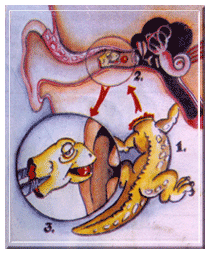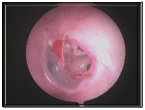| Dr. T.L. Vasudevan's | |||
| ENT SURGICAL CLINIC | |||
| HISTORY OF E.N.T | |||
|
"The longer you can look back, the further you can look" | |||
| - Sir. W. Churchill. | |||
 |
|||
In 1560 A.D., Johannes Arcularius advised an extremely peculiar treatment for removing a Foreign body from the ear. The head of a lizard was cutoff, placed in the ear canal and be allowed to remain therefore 3-4 hrs. Finally when the head is removed, the foreign body is usually found in the mouth of the severed lizard. In 1640, Marcus Baze first attempted to replace the Tympanic membrane artificially by placing an Ivory rod in the ear, the end of which was covered by a pig bladder. In 1960, Johann Hartmann described a procedure for detecting wax in the ear. He placed a silver tube in the ear and blew through it. If the patient felt the breath cold, the deafness was not due to impacted wax. (It has always been a convention when you talk of history to start from the stone age. But please be very clear in your mind that we do not practice any of these procedures in our clinic | |||
| - Honorary editor) | |||
| Back << | |||
| TIPS FOR THE PRACTITIONER | |||
| Blunt Trauma to the ear | |||
| Endoscopic view of the tympanic membrane which has a perforation due to trauma. (the incus and stapes head are well seen) | |||
 Very often general practitioners come across cases with bleeding from ears usually following. Blunt trauma to the ear can be a part of generalized trauma to that side of the face or specifically to the ear, like a slap on the ear. Both can cause perforation of the ear drum. One should keep in mind the following hints while treating such cases : Very often general practitioners come across cases with bleeding from ears usually following. Blunt trauma to the ear can be a part of generalized trauma to that side of the face or specifically to the ear, like a slap on the ear. Both can cause perforation of the ear drum. One should keep in mind the following hints while treating such cases : |
|||
| 1. Ear drios are strictly forbidden. Applying ear drops to the ear is a common thing advocated by doctors for any and every ear symptom and also indiscriminately by the patient as self medication. Infact, an eardrop is the last in priority even in infected condition of the ear in our practice and especially when a case is refered to us if ear drops are applied a spot diagnosis of the condition becomes difficult. It can introduce infection intracranially in case of a fracture base of skull. In case of rupture of the tympanic membrane following a slap, ear drops can result in a ear discharge, impeding the healing of the tympanic membrane which would otherwise heal very rapidly. | |||
|
2. Conservative management of a case of blunt trauma to the ear (slap) by keeping the ear absolutely dry will facilitate faster healing. To prevent water entering the ear while bathing, a cotton wool can be plugged into the ear canal and its outside generously smeared with Vaseline. | |||
|
3. Prevention and prompt treatment of common cold. Nasal drops plays an important role. 4. Bleeding from the ear following trauma to the head usually implies fracture base of skull, but an impact to the chin can also result in bleeding from ear since the impact gets transferred to the temporomandibular joint through the mandible, which inturn damages the bony external auditory canal. | |||
| >> Page 4 | |||